12.1: Value of Biodiversity
- Page ID
- 111128
\( \newcommand{\vecs}[1]{\overset { \scriptstyle \rightharpoonup} {\mathbf{#1}} } \)
\( \newcommand{\vecd}[1]{\overset{-\!-\!\rightharpoonup}{\vphantom{a}\smash {#1}}} \)
\( \newcommand{\id}{\mathrm{id}}\) \( \newcommand{\Span}{\mathrm{span}}\)
( \newcommand{\kernel}{\mathrm{null}\,}\) \( \newcommand{\range}{\mathrm{range}\,}\)
\( \newcommand{\RealPart}{\mathrm{Re}}\) \( \newcommand{\ImaginaryPart}{\mathrm{Im}}\)
\( \newcommand{\Argument}{\mathrm{Arg}}\) \( \newcommand{\norm}[1]{\| #1 \|}\)
\( \newcommand{\inner}[2]{\langle #1, #2 \rangle}\)
\( \newcommand{\Span}{\mathrm{span}}\)
\( \newcommand{\id}{\mathrm{id}}\)
\( \newcommand{\Span}{\mathrm{span}}\)
\( \newcommand{\kernel}{\mathrm{null}\,}\)
\( \newcommand{\range}{\mathrm{range}\,}\)
\( \newcommand{\RealPart}{\mathrm{Re}}\)
\( \newcommand{\ImaginaryPart}{\mathrm{Im}}\)
\( \newcommand{\Argument}{\mathrm{Arg}}\)
\( \newcommand{\norm}[1]{\| #1 \|}\)
\( \newcommand{\inner}[2]{\langle #1, #2 \rangle}\)
\( \newcommand{\Span}{\mathrm{span}}\) \( \newcommand{\AA}{\unicode[.8,0]{x212B}}\)
\( \newcommand{\vectorA}[1]{\vec{#1}} % arrow\)
\( \newcommand{\vectorAt}[1]{\vec{\text{#1}}} % arrow\)
\( \newcommand{\vectorB}[1]{\overset { \scriptstyle \rightharpoonup} {\mathbf{#1}} } \)
\( \newcommand{\vectorC}[1]{\textbf{#1}} \)
\( \newcommand{\vectorD}[1]{\overrightarrow{#1}} \)
\( \newcommand{\vectorDt}[1]{\overrightarrow{\text{#1}}} \)
\( \newcommand{\vectE}[1]{\overset{-\!-\!\rightharpoonup}{\vphantom{a}\smash{\mathbf {#1}}}} \)
\( \newcommand{\vecs}[1]{\overset { \scriptstyle \rightharpoonup} {\mathbf{#1}} } \)
\( \newcommand{\vecd}[1]{\overset{-\!-\!\rightharpoonup}{\vphantom{a}\smash {#1}}} \)
Biodiversity is a broad term for the variety of life on Earth. Traditionally, ecologists have measured biodiversity by taking into account both the number of species and the number of individuals of each species. However, biologists now measure biodiversity at a number of organizational levels, including ecosystem, species, and genetic diversity. This focuses efforts to preserve the biologically and technologically important elements of biodiversity.
Biodiversity is important to the survival and welfare of human populations because it has impacts on our health and our ability to feed ourselves through agriculture and harvesting populations of wild animals. Loss of biodiversity may have reverberating consequences on ecosystems because of the complex interrelations among species. For example, the extinction of one species may cause the extinction of another.
Ecosystem Diversity
Measuring biodiversity on a large scale involves measuring ecosystem diversity, the number of different ecosystems on Earth or in a geographical area as well as their relative abundances. The loss of an ecosystem means the loss of the interactions between species and the loss of biological productivity that an ecosystem is able to create. An example of a largely extinct ecosystem in North America is the prairie ecosystem (figure \(\PageIndex{1}\)). Prairies once spanned central North America from the boreal forest in northern Canada down into Mexico. They are now all but gone, replaced by crop fields, pasture lands, and suburban sprawl. Many of the species survive, but the hugely productive ecosystem that was responsible for creating our most productive agricultural soils is now gone. As a consequence, their soils are now being depleted unless they are maintained artificially at great expense.
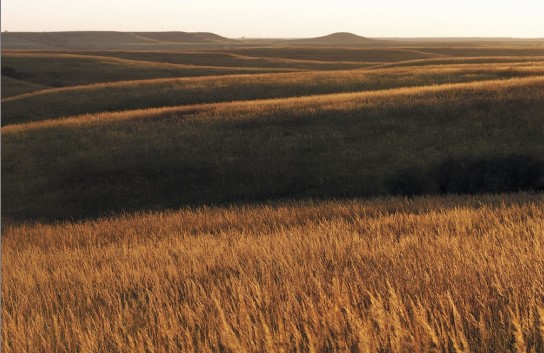
The soil productivity described above is an example of an ecosystem service. These are the products and processes associated with biological systems and are directly or indirectly of immense value to the well-being of people. Some ecosystem services are processes such as the regulation of climate, flooding, and disease. Nutrient cycling, pollination, and regulation of crop pests are ecosystem services important to food production (see the Food Production and Ecosystem Services box below). The water cycle provides fresh water, and photosynthesis adds oxygen to our air. Other ecosystem services are human provisions including food, fuel, and fiber (such as cotton for clothing or timber). Medicines are another important provision. Furthermore, healthy ecosystems allow for recreational activities, such as hiking, kayaking, and camping, and educational opportunities, such as field trips. Nature is also the basis for a significant part of aesthetic and spiritual values held by many cultures.
In 1997, Robert Costanza and his colleagues estimated to annual value of ecosystem services to be $33 trillion dollars ($53 trillion in 2019 dollars), and many consider this to be an underestimation. For comparison the gross domestic product of the United States in 2020 was $21 trillion. Valuing ecosystem services can be difficult, particular for those services that are processes rather than provisions. One strategy is to calculate replacement cost. For example, how much would it cost to control a pest population if it was not regulated by natural processes? Figure \(\PageIndex{2}\) illustrates the value of a few ecosystem services.
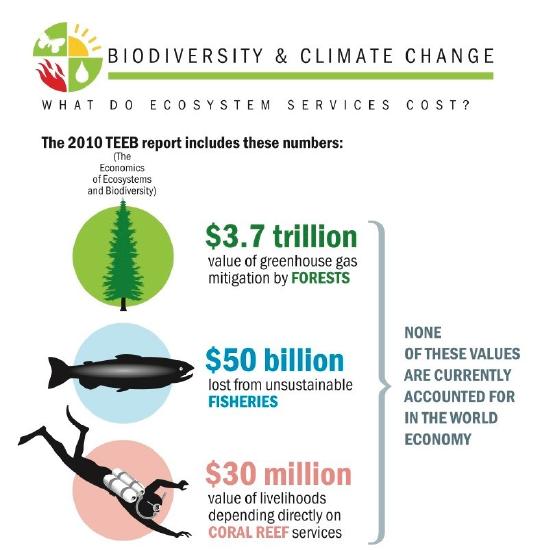
Food Production
Agriculture
Food production relies on several interacting ecosystem services. Most soils contain a huge diversity of organisms that maintain nutrient cycles, breaking down organic matter into nutrient compounds that crops need for growth. These organisms also maintain soil texture that affects water and oxygen dynamics in the soil that are necessary for plant growth. Replacing the work of these organisms in forming arable (farmable) soil is not practically possible. They occur within ecosystems, such as soil ecosystems, as a result of the diverse metabolic activities of the organisms living there, but they provide benefits to human food production, drinking water availability, and breathable air.
Other key ecosystem services related to food production are plant pollination and crop pest control. It is estimated that honeybee pollination within the United States brings in $1.6 billion per year; other pollinators contribute up to $6.7 billion. Over 150 crops in the United States require pollination to produce. Many honeybee populations are managed by beekeepers who rent out their hives’ services to farmers. Honeybee populations in North America have been suffering large losses caused by a syndrome known as colony collapse disorder, a phenomenon with complex and interacting causes.
Other pollinators include a diverse array of other bee species and various insects and birds. Loss of these species would make growing crops requiring pollination impossible, increasing dependence on other crops. A 2002 study by Claire Kremen and colleagues found that native pollinators in Central California (those that historically occurred there; figure \(\PageIndex{3}\) and 4) provided full pollination to watermelon crops. This was only true on organic farms that were located near the natural habitat for these pollinators, highlighting the importance of sustainable farming practices and habitat conservation in preserving ecosystem services. Essentially, in a healthy ecosystem, native pollinators eliminated the need for rented honeybee hives. Note that while honeybees are valuable in an agricultural setting, they are not native to North America and can disrupt ecosystems by competing with native bees.
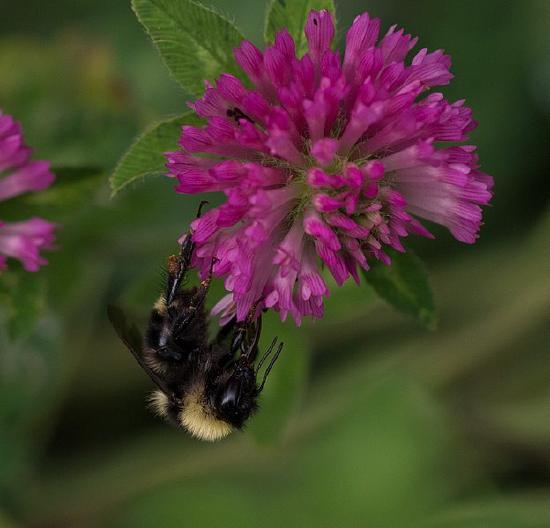
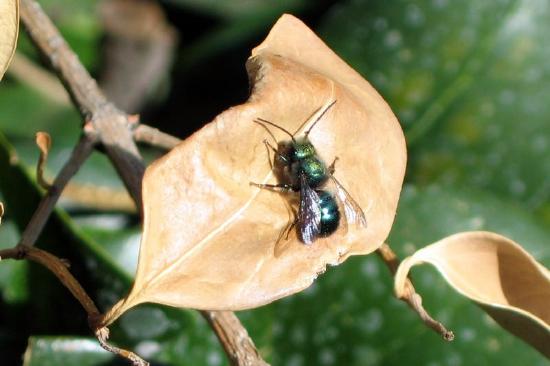
Finally, humans compete for their food with crop pests, most of which are insects. Pesticides control these competitors, but these are costly and lose their effectiveness over time as pest populations adapt. They also lead to collateral damage by killing non-pest species as well as beneficial insects like honeybees, and risking the health of agricultural workers and consumers. Moreover, these pesticides may migrate from the fields where they are applied and do damage to other ecosystems like streams, lakes, and even the ocean (see Industrial Agriculture and Environmental Toxicology). Ecologists believe that the bulk of the work in removing pests is actually done by predators and parasites of those pests, but the impact has not been well studied. A review found that in 74 percent of studies that looked for an effect of landscape complexity (forests and fallow fields near to crop fields) on natural enemies of pests, the greater the complexity, the greater the effect of pest-suppressing organisms. Another experimental study found that introducing multiple enemies of pea aphids (an important alfalfa pest) increased the yield of alfalfa significantly. This study shows that a diversity of pests is more effective at control than one single pest. Loss of diversity in pest enemies will inevitably make it more difficult and costly to grow food. The world’s growing human population faces significant challenges in the increasing costs and other difficulties associated with producing food.
Wild Food Sources
In addition to growing crops and raising food animals, humans obtain food resources from wild populations, primarily wild fish populations. For about one billion people, aquatic resources provide the main source of animal protein. But since 1990, production from global fisheries has declined. Despite considerable effort, few fisheries on Earth are managed sustainability.
When most people think of fishing, we imagine relaxing in a boat and patiently reeling in the day’s catch. But modern industrial fishing -- the kind that stocks our grocery shelves -- looks more like warfare. Ayana Elizabeth Johnson and Jennifer Jacquet explain overfishing and its effects on ecosystems, food security, jobs, economies, and coastal cultures.
Fishery extinctions rarely lead to complete extinction of the harvested species, but rather to a radical restructuring of the marine ecosystem in which a dominant species is so over-harvested that it becomes a minor player, ecologically. In addition to humans losing the food source, these alterations affect many other species in ways that are difficult or impossible to predict. The collapse of fisheries has dramatic and long-lasting effects on local human populations that work in the fishery. In addition, the loss of an inexpensive protein source to populations that cannot afford to replace it will increase the cost of living and limit societies in other ways. In general, the fish taken from fisheries have shifted to smaller species and the larger species are overfished. The ultimate outcome could clearly be the loss of aquatic systems as food sources.
Species Diversity
Species diversity is the number of different species in a particular area and their relative abundance. The area in question could be a habitat, a biome, or the entire biosphere. Areas with low species diversity, such as the glaciers of Antarctica, still contain a wide variety of living organisms, whereas the diversity of tropical rainforests is so great that it cannot be accurately assessed. Species richness, the number of species living in a habitat or other unit, is one component of biodiversity. Species evenness is a component of species diversity based on relative abundance (the number individuals in a species relative to the total number of individuals in all species within a system).
The Number of Species on Earth
Despite considerable effort, knowledge of the species that inhabit the planet is limited. About 1.5 million species have been described, but many more species are yet to be identified. Estimates of the total number of species on Earth range from 3 million to 100 million, with more recent estimates commonly ranging from 8 to 11 million species. A 2011 study suggests that only 13% of eukaryotic species (such as plants, animals, fungi, and algae) have been named (Table \(\PageIndex{1}\). Estimates of numbers of prokaryotic species (such as bacteria) are largely guesses, but biologists agree that science has only just begun to catalog their diversity. In fact, a 2017 study by Brendan Larsen and colleagues estimated that there are actually 1-6 billion species on Earth with at least 70% of them being bacteria. Given that Earth is losing species at an accelerating pace, science knows little about what is being lost.
| Type of Organism | Mora et al. 2011 Described | Mora et al. 2011 Predicted | Chapman 2009 Described | Chapman 2009 Predicted | Groombridge and Jenkins 2002 Described | Groombridge and Jenkins 2002 Predicted |
|---|---|---|---|---|---|---|
| Animals | 1,124,516 | 9,920,000 | 1,424,153 | 6,836,330 | 1,225,500 | 10,820,000 |
| Photosynthetic protists (such as algae) | 17,892 | 34,900 | 25,044 | 200,500 | No data | No data |
| Fungi | 44,368 | 616,320 | 98,998 | 1,500,000 | 72,000 | 1,500,000 |
| Plants | 224,244 | 314,600 | 310,129 | 390,800 | 270,000 | 320,000 |
| Non-photosynthetic protists | 16,236 | 72,800 | 28,871 | 1,000,000 | 80,000 | 600,000 |
| Prokaryotes | No data | No data | 10,307 | 1,000,000 | 10,175 | No data |
| Total | 1,438,769 | 10,960,000 | 1,897,502 | 10,897,630 | 1,657,675 | 13,240,000 |
There are various initiatives to catalog described species in accessible and more organized ways, and the internet is facilitating that effort. Nevertheless, at the current rate of species description, which according to the State of Observed Species reports is 17,000–20,000 new species a year, it would take close to 500 years to describe all of the species currently in existence. The task, however, is becoming increasingly impossible over time as extinction removes species from Earth faster than they can be described.
Naming and counting species may seem an unimportant pursuit given the other needs of humanity, but it is not simply an accounting. Describing species is a complex process by which biologists determine an organism’s unique characteristics and whether or not that organism belongs to any other described species. It allows biologists to find and recognize the species after the initial discovery to follow up on questions about its biology. That subsequent research will produce the discoveries that make the species valuable to humans and to our ecosystems. Without a name and description, a species cannot be studied in depth and in a coordinated way by multiple scientists.
Importance of Species Diversity
Healthy ecosystems contain a diversity of species, and each species plays a role in ecosystem function; therefore, species diversity as well as ecosystem diversity are essential to maintaining ecosystem services. For example, many medications are derived from natural chemicals made by a diverse group of organisms. For example, many plants produce compounds meant to protect the plant from insects and other animals that eat them. Some of these compounds also work as human medicines. Contemporary societies that live close to the land often have a broad knowledge of the medicinal uses of plants growing in their area. For centuries in Europe, older knowledge about the medical uses of plants was compiled in herbals—books that identified the plants and their uses. Humans are not the only animals to use plants for medicinal reasons. The other great apes, orangutans, chimpanzees, bonobos, and gorillas have all been observed self-medicating with plants.
Modern pharmaceutical science also recognizes the importance of these plant compounds. Examples of significant medicines derived from plant compounds include aspirin, codeine, digoxin, atropine, and vincristine (figure \(\PageIndex{6}\)). Many medications were once derived from plant extracts but are now synthesized. It is estimated that, at one time, 25 percent of modern drugs contained at least one plant extract. That number has probably decreased to about 10 percent as natural plant ingredients are replaced by synthetic versions of the plant compounds. Antibiotics, which are responsible for extraordinary improvements in health and lifespans in developed countries, are compounds largely derived from fungi and bacteria.
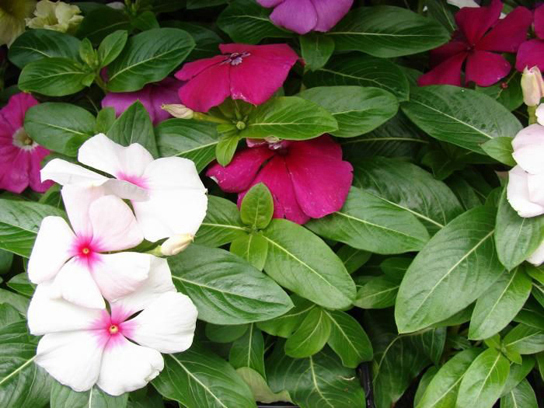
In recent years, animal venoms and poisons have excited intense research for their medicinal potential. By 2007, the FDA had approved five drugs based on animal toxins to treat diseases such as hypertension, chronic pain, and diabetes. Another five drugs are undergoing clinical trials and at least six drugs are being used in other countries. Other toxins under investigation come from mammals, snakes, lizards, various amphibians, fish, snails, octopuses, and scorpions.
Aside from representing billions of dollars in profits, these medications improve people’s lives. Pharmaceutical companies are actively looking for new natural compounds that can function as medicines. It is estimated that one third of pharmaceutical research and development is spent on natural compounds and that about 35 percent of new drugs brought to market between 1981 and 2002 were from natural compounds.
Genetic Diversity
In contrast to ecosystem and species diversity, genetic diversity is the total number of genetic characteristics in the genetic makeup of a species, it ranges widely from the number of species to differences within species and can be attributed to the span of survival for a species. Genetic diversity provides the raw material for evolutionary adaptation, the process by which the genetic composition of populations change over time in a way that makes it more suited to the environment. With more variation, it is more likely that some individuals in a population will possess variations of alleles (versions of genes) that are suited for the environment. Those individuals are more likely to survive to produce offspring bearing those same beneficial genes. The population will continue for more generations because of the success of these individuals.
Loss of genetic diversity makes a species less able to reproduce successfully and less adaptable to a changing environment or to a new disease. Small populations of species are especially susceptible to loss of genetic diversity. When a species loses too many individuals, it becomes genetically uniform. Some of the causes for the loss in genetic diversity include: inbreeding among closely related individuals and genetic drift, the process by which the genetic composition of a population fluctuates randomly over time.
Low genetic diversity makes the Tasmanian devil (figure \(\PageIndex{7}\)) especially vulnerable to Devil Facial Tumor Disease (DFTD), a cancer that threatens it with extinction. Contagious cancers are typically spread by viruses, which can transmit cancer-causing genes; however, in the case of DFTD, the cancerous cells themselves are spread among individuals. Usually, the immune system can recognize cancerous cells, infected cells, and foreign cells, but DFTD cells evade the immune system. If Tasmanian devils had high genetic diversity, it is likely that some individuals would have alleles that made them resistant to DFTD. These individuals would survive and reproduce more frequently than others, and the resistant alleles would become more common in the population (evolutionary adaptation would occur). Because Tasmanian devils have low genetic diversity, there is less opportunity for such evolutionary adaptation.
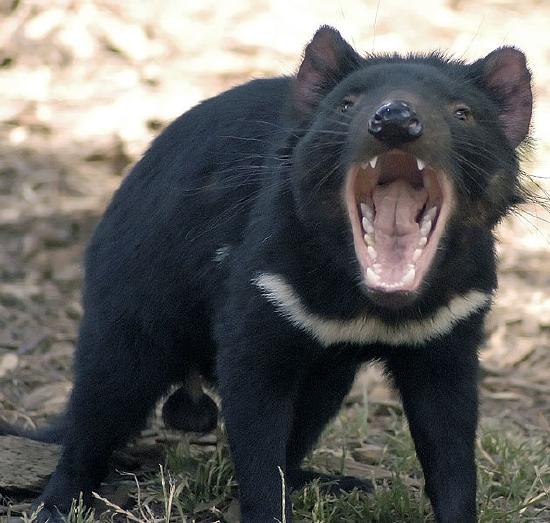
Genetic diversity is important to agriculture. Since the beginning of human agriculture more than 10,000 years ago, human groups have been breeding and selecting crop varieties. This crop diversity matched the cultural diversity of highly subdivided populations of humans. For example, potatoes were domesticated beginning around 7,000 years ago in the central Andes of Peru and Bolivia. The people in this region traditionally lived in relatively isolated settlements separated by mountains. The potatoes grown in that region belong to seven species and the number of varieties likely is in the thousands. Each variety has been bred to thrive at particular elevations and soil and climate conditions. The diversity is driven by the diverse demands of the dramatic elevation changes, the limited movement of people, and the demands created by crop rotation for different varieties that will do well in different fields.
The potato demonstrates a well-known example of the risks of low crop diversity: during the tragic Irish potato famine (1845–1852 AD), the single potato variety grown in Ireland became susceptible to a potato blight—wiping out the crop (figure \(\PageIndex{8}\)). The loss of the crop led to famine, death, and mass emigration. Resistance to disease is a chief benefit to maintaining crop biodiversity and lack of diversity in contemporary crop species carries similar risks. Seed companies, which are the source of most crop varieties in developed countries, must continually breed new varieties to keep up with evolving pest organisms. These same seed companies, however, have participated in the decline of the number of varieties available as they focus on selling fewer varieties in more areas of the world replacing traditional local varieties.

Potatoes are only one example of agricultural diversity. Every plant, animal, and fungus that has been cultivated by humans has been bred from original wild ancestor species into diverse varieties arising from the demands for food value, adaptation to growing conditions, and resistance to pests. The ability to create new crop varieties relies on the diversity of varieties available and the availability of wild forms related to the crop plant. These wild forms are often the source of new gene variants that can be bred with existing varieties to create varieties with new attributes. Loss of wild species related to a crop will mean the loss of potential in crop improvement. Maintaining the genetic diversity of wild species related to domesticated species ensures our continued supply of food.
Since the 1920s, government agriculture departments have maintained seed banks of crop varieties as a way to maintain crop diversity. This system has flaws because over time seed varieties are lost through accidents and there is no way to replace them. In 2008, the Svalbard Global seed Vault, located on Spitsbergen island, Norway, (figure \(\PageIndex{9}\)) began storing seeds from around the world as a backup system to the regional seed banks. If a regional seed bank stores varieties in Svalbard, losses can be replaced from Svalbard should something happen to the regional seeds. The Svalbard seed vault is deep into the rock of the arctic island. Conditions within the vault are maintained at ideal temperature and humidity for seed survival, but the deep underground location of the vault in the arctic means that failure of the vault’s systems will not compromise the climatic conditions inside the vault.
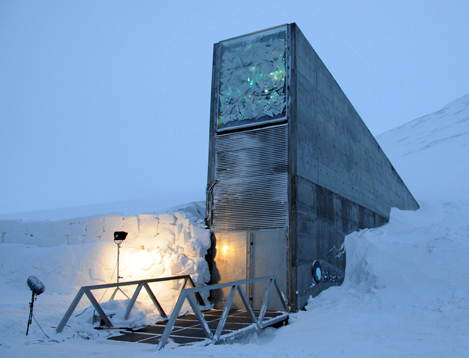
References
Costanza, R., d'Arge, R., de Groot, R. et al. The value of the world's ecosystem services and natural capital. Nature 387, 253–260 (1997). DOI
Kremen, C., Williams, N. M., and Thorp, R. W. Crop pollination from native bees at risk from agricultural intensification. PNAS 99, 6812-16816 (2002). DOI
Brendan B. Larsen, Elizabeth C. Miller, Matthew K. Rhodes, and John J. Wiens, "Inordinate Fondness Multiplied and Redistributed: the Number of Species on Earth and the New Pie of Life," The Quarterly Review of Biology 92, no. 3 (September 2017): 229-265.
Attributions
This page is a modified derivative of
- Genetic diversity by wikipedia (license CC BY-SA 4.0)
- 9.1 Ecosystem Diversity from Environmental Science by Melissa Ha and Rachel Schleiger (license CC BY-NC 4.0)
- 9.2 Species Diversity from Environmental Science by Melissa Ha and Rachel Schleiger (license CC BY-NC 4.0)
- 9.3 Genetic Diversity from Environmental Science by Melissa Ha and Rachel Schleiger (license CC BY-NC 4.0)

